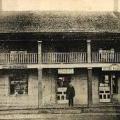 Mail delivery in the Eastern Townships dates to about 1800. At that early date, virtually all of the settlers in the region were recent arrivals from New England. These people were anxious to maintain their ties to their old country and to the friends and family they left behind. It was important, then, that they continue to receive letters and newspapers from back home. The Green Mountain Patriot, published in Peacham, Vermont provided popular reading in those days.
Mail delivery in the Eastern Townships dates to about 1800. At that early date, virtually all of the settlers in the region were recent arrivals from New England. These people were anxious to maintain their ties to their old country and to the friends and family they left behind. It was important, then, that they continue to receive letters and newspapers from back home. The Green Mountain Patriot, published in Peacham, Vermont provided popular reading in those days.
According to Townships historian B. F. Hubbard, the area close to Vermont was served on an irregular basis by post-riders coming up through Vermont from Wells River to Derby Line on the border (and hence Stanstead Plain). These post-riders would deliver their mail about twice a month. As their business increased, they extended their trips into Stanstead, Barnston, Hatley, and Compton townships. In 1812, a regular mail route was opened up from Wells River to Derby Line (and Stanstead).
The War of 1812 probably put a stop to cross-border delivery, and certainly must have called attention to the lack of service in the region. However, there was no regular mail service in the Eastern Townships before 1817. Government dispatches were sent by special courier. In 1817, a mail route was finally opened up from Stanstead to Quebec City, via Melbourne and the Craig Road, with mail carried weekly on horseback.
With improvements to the road network and the development of stagecoach service in the 1820s and 1830s, mail delivery was established between the Townships and Montreal and also between the Townships and Quebec City. In 1824, a weekly summer service was started between Stanstead and Montreal via Copp's Ferry and Magog where post offices were opened. Elsewhere, other routes were taking shape.
Among the first post offices in Lower Canada were those at Philipsburg (1812) and Drummondville (1816). By 1817, Stanstead, Lower Forks (Sherbrooke), Ascot, Hatley, Shipton, and Richmond all had post offices. Then followed Granby (1826), Dunham (1827), Georgeville and Shefford (1829), and Frelighsburg (1831). Magog, Brome, Potton, and Cowansville had their own as well.
The earliest post offices operated out of general stores or private homes. This practice continued with the development of rural delivery at the beginning of the 20th century. Some villages in the Eastern Townships were even named after their first postmasters. Examples of this are Sweetsburg, Churchville, and Cowansville.
One of the strangest post offices on record was the so-called "world's only double post office," located in the border village of Beebe Plain. The post office had two doors, one in the U.S., the other in Canada; two postal counters; and one postmaster serving customers from both sides of the line. The building, now a private residence, still stands.